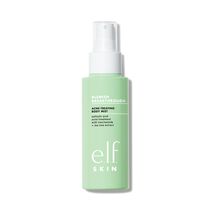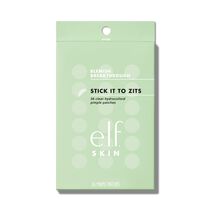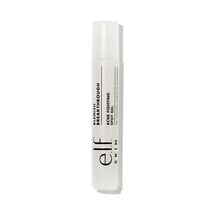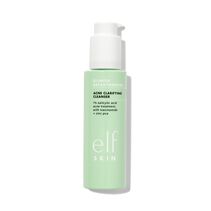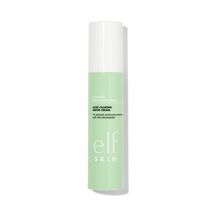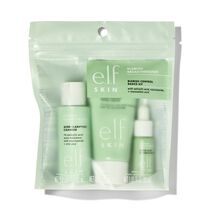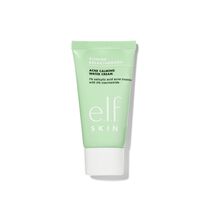blemish
breakthrough fam
Blemish Breakthrough Collection
156 Reviews
2 Free Minis with $35+, 1 Full Size Product with $50+
2975 Reviews
2 Free Minis with $35+, 1 Full Size Product with $50+
1006 Reviews
2 Free Minis with $35+, 1 Full Size Product with $50+
4109 Reviews
2 Free Minis with $35+, 1 Full Size Product with $50+
187 Reviews
2 Free Minis with $35+, 1 Full Size Product with $50+
2848 Reviews
2 Free Minis with $35+, 1 Full Size Product with $50+
54 Reviews
2 Free Minis with $35+, 1 Full Size Product with $50+
2 Free Minis with $35+, 1 Full Size Product with $50+

Skin Care for Acne and Blemish-Prone Skin FAQs
If you're looking for skincare products for acne-prone skin, e.l.f. Cosmetics is a great start. We recommend trying our Blemish Breakthrough collection that includes a range of products, such as our Acne-Treating Body Mist, Stick It To Zits Pimple Patches, Acne Clarifying Cleanser, and many more.
Acne is a skin condition that occurs when hair follicles become clogged with oil and dead skin cells, according to the American Academy of Dermatology. This can happen due to factors such as hormonal changes, genetics, and certain types of bacteria on the skin. The clogged hair follicles can then lead to the development of pimples, blackheads, and other types of acne.
A good skincare routine for acne should include cleansing, toning, and moisturizing, as well as exfoliating once a week to help remove dead skin cells. Use a gentle cleanser that contains salicylic acid to help clear breakouts. Follow up with a hydrating night serum to help resurface skin to help improve the look of skin tone and texture. Finally, apply a lightweight moisturizer to help keep your skin hydrated.
Pimple patches are small adhesive bandages infused with hydrocolloid that is designed to visibly reduce the look of blemishes. They work by creating a protective barrier over the blemish, which helps to flatten the look of blemishes, while extracting impurities and protecting skin for faster healing. Using pimple patches can be a gentle, non-invasive way to help manage acne.
Read more on what pimple patches are and how they work.
There are different forms of acne that people may experience. According to the National Institutes of Health, these types of acne may include but are not limited to:
-
Whiteheads: These are also called closed comedones. These may occur when a pore becomes clogged with dead skin cells, oil, and bacteria. The clogged pore appears as a small, flesh-colored papule with a white, keratin-filled center.
-
Blackheads: These are also called open comedones. These may form when a pore becomes clogged with a mixture of dead skin cells, oil, and bacteria. The top of the pore stays open, and the clog oxidizes, giving it a dark color.
-
Pustules: These are also called pimples. They form when a clogged pore becomes infected with bacteria. The skin around the pore may become inflamed, and a red bump filled with pus forms.
-
Nodules: These are large, solid, painful lumps that form deep under the skin. These may occur when a clogged pore becomes infected, and the infection causes inflammation deep within the skin.
-
Cysts: These are large, pus-filled lumps that form under the skin. These may occur when a clogged pore becomes infected and the infection spreads, causing a large, painful bump to form.
Acne-prone skin can be frustrating to deal with, but there are steps you can take to help improve its appearance. First, we recommend cleansing your face twice a day with a gentle, non-comedogenic cleanser. This may help to remove excess oil and dirt that can contribute to acne. Additionally, consider using products that contain acne-fighting ingredients, which can help to penetrate pores to control acne. Finally, help protect your skin from the sun by using a daily moisturizer with SPF.
Read more on how to get acne-prone skin summer ready in 5 easy steps.
If you have acne-prone skin, skipping moisturizer might seem like a good idea, but it can actually do more harm than good. Moisturizers can help to keep your skin hydrated and healthy-looking. If you have acne-prone skin, we recommend looking for a lightweight, non-comedogenic moisturizer. Incorporating a moisturizer with acne-fighting ingredients to your skincare routine may help to balance your skin's natural oil production and help keep acne at bay.
Acne-prone skin is a common condition that can affect many people. If you are unsure whether or not you have acne-prone skin, there are a few key signs to look out for. The first is the presence of blackheads, whiteheads, or pimples. These can often be found on the face, chest, and back. Additionally, if you tend to break out easily or have oily skin, this may be an indication that you are prone to developing acne. It's important to understand your skin type so you can properly treat and care for it.
Acne spot treatment should be applied before moisturizer in order to help target and treat specific areas of the skin. Moisturizer can then be applied to the rest of the face to provide hydration and nourishment. It's important to wait a few minutes after applying the spot treatment before adding moisturizer to allow it to properly absorb into the skin.
